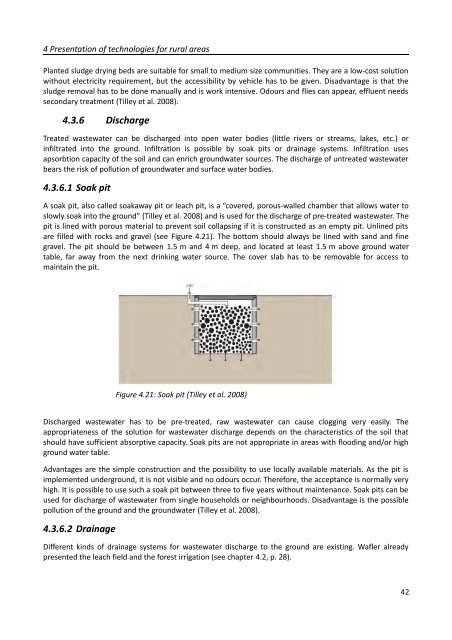MASTER'S THESIS - SuSanA
MASTER'S THESIS - SuSanA
MASTER'S THESIS - SuSanA
You also want an ePaper? Increase the reach of your titles
YUMPU automatically turns print PDFs into web optimized ePapers that Google loves.
4 Presentation of technologies for rural areas<br />
Planted sludge drying beds are suitable for small to medium size communities. They are a low-cost solution<br />
without electricity requirement, but the accessibility by vehicle has to be given. Disadvantage is that the<br />
sludge removal has to be done manually and is work intensive. Odours and flies can appear, effluent needs<br />
secondary treatment (Tilley et al. 2008).<br />
4.3.6 Discharge<br />
Treated wastewater can be discharged into open water bodies (little rivers or streams, lakes, etc.) or<br />
infiltrated into the ground. Infiltration is possible by soak pits or drainage systems. Infiltration uses<br />
apsorbtion capacity of the soil and can enrich groundwater sources. The discharge of untreated wastewater<br />
bears the risk of pollution of groundwater and surface water bodies.<br />
4.3.6.1 Soak pit<br />
A soak pit, also called soakaway pit or leach pit, is a “covered, porous-walled chamber that allows water to<br />
slowly soak into the ground” (Tilley et al. 2008) and is used for the discharge of pre-treated wastewater. The<br />
pit is lined with porous material to prevent soil collapsing if it is constructed as an empty pit. Unlined pits<br />
are filled with rocks and gravel (see Figure 4.21). The bottom should always be lined with sand and fine<br />
gravel. The pit should be between 1.5 m and 4 m deep, and located at least 1.5 m above ground water<br />
table, far away from the next drinking water source. The cover slab has to be removable for access to<br />
maintain the pit.<br />
Figure 4.21: Soak pit (Tilley et al. 2008)<br />
Discharged wastewater has to be pre-treated, raw wastewater can cause clogging very easily. The<br />
appropriateness of the solution for wastewater discharge depends on the characteristics of the soil that<br />
should have sufficient absorptive capacity. Soak pits are not appropriate in areas with flooding and/or high<br />
ground water table.<br />
Advantages are the simple construction and the possibility to use locally available materials. As the pit is<br />
implemented underground, it is not visible and no odours occur. Therefore, the acceptance is normally very<br />
high. It is possible to use such a soak pit between three to five years without maintenance. Soak pits can be<br />
used for discharge of wastewater from single households or neighbourhoods. Disadvantage is the possible<br />
pollution of the ground and the groundwater (Tilley et al. 2008).<br />
4.3.6.2 Drainage<br />
Different kinds of drainage systems for wastewater discharge to the ground are existing. Wafler already<br />
presented the leach field and the forest irrigation (see chapter 4.2, p. 28).<br />
42

















